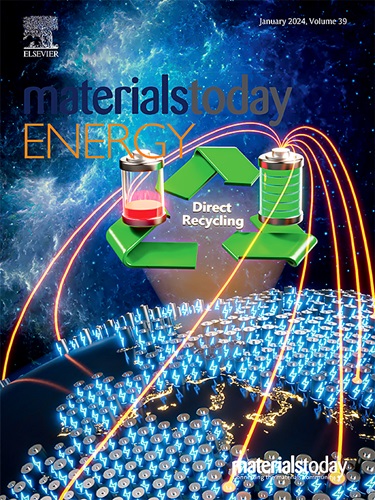Core-shell nanofiber separator incorporated with PDA-PEI co-modified Li0.33La0.57TiO3 nanowires prepared by co-axial electrospinning for dendrite-free lithium metal batteries
IF 8.6
2区 材料科学
Q1 CHEMISTRY, PHYSICAL
引用次数: 0
Abstract
The core-shell nanofibers containing PDA-PEI co-modified LiLaTiO (LLTO) perovskite nanowires in the shell layer were fabricated by co-axial electrospinning technique to apply as separator in dendrite-free lithium metal batteries. The PVDF-HFP with good mechanical properties and polar C–F bonds was used as the core material, and polyacrylonitrile (PAN) with high thermal stability was employed as the shell layer in nanofibers. The PDA-PEI co-modified LiLaTiO nanowires, reacting with PF anions in LiPF salt can not only capture free anions but also provide a lithium-ion migration pathway. Moreover, the core-shell structured nanofibers exhibited high mechanical strength (9.2 N/mm), robust thermal stability (>0% at 200 °C for 1 h), and favorable electrolyte affinity (electrolyte uptake of 732%). Gelation of PVDF-HFP in liquid electrolyte leads to high-ionic conductivity (3.52 mS/cm), Li transference number (t = 0.68), uniform Li flux, and smooth Li deposition. The Li plating/stripping test consisting of Li–Li cells (with CS/LLTO-PDA-PEI) carried out at 0.4 mA/cm was conducted for 1000 h without a short circuit. NCM-Li and NCM-Gr coin cells using the CS (core-shell)/LLTO-PDA-PEI separator retained long-term cycle stability and good Coulombic efficiency (CE).通过共轴电纺丝法制备的、含有 PDA-PEI 共修饰 Li0.33La0.57TiO3 纳米线的核壳纳米纤维隔膜,用于无枝晶型锂金属电池
通过共轴电纺丝技术,制备了壳层含有 PDA-PEI 共修饰锂镧硫(LLTO)包晶石纳米线的核壳纳米纤维,并将其作为无枝晶型锂金属电池的隔膜。纳米纤维的芯材采用了具有良好机械性能和极性 C-F 键的 PVDF-HFP,外壳采用了具有高热稳定性的聚丙烯腈(PAN)。PDA-PEI 共同修饰的 LiLaTiO 纳米线与 LiPF 盐中的 PF 阴离子发生反应,不仅能捕获游离阴离子,还能提供锂离子迁移通道。此外,核壳结构纳米纤维还表现出较高的机械强度(9.2 N/mm)、较强的热稳定性(200 ℃ 1 小时>0%)和良好的电解质亲和性(电解质吸收率达 732%)。PVDF-HFP 在液态电解质中的凝胶化带来了高离子电导率(3.52 mS/cm)、锂转移数(t = 0.68)、均匀的锂通量和平滑的锂沉积。在 0.4 mA/cm 下进行的锂离子电池(含 CS/LLTO-PDA-PEI)锂镀层/剥离测试持续了 1000 小时,没有发生短路。使用 CS(核壳)/LLTO-PDA-PEI 分离器的 NCM-Li 和 NCM-Gr 纽扣电池保持了长期的循环稳定性和良好的库仑效率 (CE)。
本文章由计算机程序翻译,如有差异,请以英文原文为准。
求助全文
约1分钟内获得全文
求助全文
来源期刊

Materials Today Energy
Materials Science-Materials Science (miscellaneous)
CiteScore
15.10
自引率
7.50%
发文量
291
审稿时长
15 days
期刊介绍:
Materials Today Energy is a multi-disciplinary, rapid-publication journal focused on all aspects of materials for energy.
Materials Today Energy provides a forum for the discussion of high quality research that is helping define the inclusive, growing field of energy materials.
Part of the Materials Today family, Materials Today Energy offers authors rigorous peer review, rapid decisions, and high visibility. The editors welcome comprehensive articles, short communications and reviews on both theoretical and experimental work in relation to energy harvesting, conversion, storage and distribution, on topics including but not limited to:
-Solar energy conversion
-Hydrogen generation
-Photocatalysis
-Thermoelectric materials and devices
-Materials for nuclear energy applications
-Materials for Energy Storage
-Environment protection
-Sustainable and green materials
 求助内容:
求助内容: 应助结果提醒方式:
应助结果提醒方式:


